Exam Details
Exam Code
:MCAT-TESTExam Name
:Medical College Admission Test: Verbal Reasoning, Biological Sciences, Physical Sciences, Writing SampleCertification
:Medical Tests CertificationsVendor
:Medical TestsTotal Questions
:812 Q&AsLast Updated
:Apr 16, 2025
Medical Tests Medical Tests Certifications MCAT-TEST Questions & Answers
-
Question 551:
Compounds containing a hydroxyl group attached to a benzene ring are called phenols. Derivatives of phenols, such as naphthols and phenanthrols, have chemical properties similar to those of phenols, as do most of the many naturally-occurring substituted phenols. Like other alcohols, phenols have higher boiling points than hydrocarbons of similar molecular weight. Like carboxylic acids, phenols are more acidic than their alcohol counterparts. Phenols undergo a number of different reactions; both their hydroxyl groups and their benzene rings are highly reactive. A number of chemical tests can be used to distinguish phenols from alcohols and carboxylic acids.
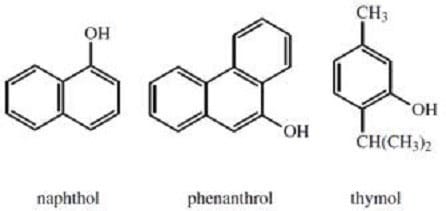
Thymol, a naturally occurring phenol, is an effective disinfectant that is obtained from thyme oil. Thymol can also be synthesized from m-cresol, as shown in Reaction A below. Thymol can then be converted to menthol, another naturally-occurring organic compound; this conversion is shown in Reaction B.
Reaction A
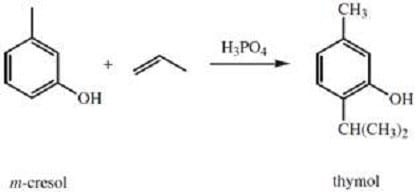
Reaction B
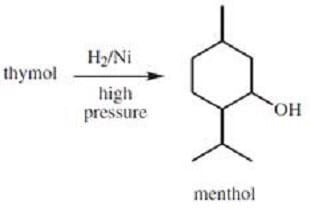
What simple chemical test could be used to distinguish between the following two compounds?
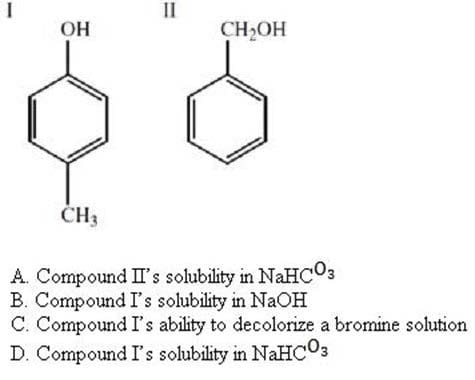
A. Option A
B. Option B
C. Option C
D. Option D
-
Question 552:
Compounds containing a hydroxyl group attached to a benzene ring are called phenols. Derivatives of phenols, such as naphthols and phenanthrols, have chemical properties similar to those of phenols, as do most of the many naturally-occurring substituted phenols. Like other alcohols, phenols have higher boiling points than hydrocarbons of similar molecular weight. Like carboxylic acids, phenols are more acidic than their alcohol counterparts. Phenols undergo a number of different reactions; both their hydroxyl groups and their benzene rings are highly reactive. A number of chemical tests can be used to distinguish phenols from alcohols and carboxylic acids.

Thymol, a naturally occurring phenol, is an effective disinfectant that is obtained from thyme oil. Thymol can also be synthesized from m-cresol, as shown in Reaction A below. Thymol can then be converted to menthol, another naturally-occurring organic compound; this conversion is shown in Reaction B.
Reaction A

Reaction B

The reaction of phenol with dilute nitric acid produces which of the following compounds?
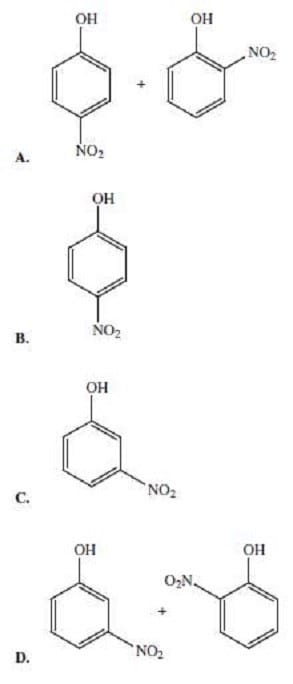
A. Option A
B. Option B
C. Option C
D. Option D
-
Question 553:
Compounds containing a hydroxyl group attached to a benzene ring are called phenols. Derivatives of phenols, such as naphthols and phenanthrols, have chemical properties similar to those of phenols, as do most of the many naturally-occurring substituted phenols. Like other alcohols, phenols have higher boiling points than hydrocarbons of similar molecular weight. Like carboxylic acids, phenols are more acidic than their alcohol counterparts. Phenols undergo a number of different reactions; both their hydroxyl groups and their benzene rings are highly reactive. A number of chemical tests can be used to distinguish phenols from alcohols and carboxylic acids.

Thymol, a naturally occurring phenol, is an effective disinfectant that is obtained from thyme oil. Thymol can also be synthesized from m-cresol, as shown in Reaction A below. Thymol can then be converted to menthol, another naturally-occurring organic compound; this conversion is shown in Reaction B.
Reaction A

Reaction B

Which of the following shows the order of decreasing acidity among the four compounds below?

A. I, III, IV, II
B. IV, I, II, III
C. IV, III, II, I
D. IV, II, I, III
-
Question 554:
Compounds containing a hydroxyl group attached to a benzene ring are called phenols. Derivatives of phenols, such as naphthols and phenanthrols, have chemical properties similar to those of phenols, as do most of the many naturally-occurring substituted phenols. Like other alcohols, phenols have higher boiling points than hydrocarbons of similar molecular weight. Like carboxylic acids, phenols are more acidic than their alcohol counterparts. Phenols undergo a number of different reactions; both their hydroxyl groups and their benzene rings are highly reactive. A number of chemical tests can be used to distinguish phenols from alcohols and carboxylic acids.

Thymol, a naturally occurring phenol, is an effective disinfectant that is obtained from thyme oil. Thymol can also be synthesized from m-cresol, as shown in Reaction A below. Thymol can then be converted to menthol, another naturally-occurring organic compound; this conversion is shown in Reaction B.
Reaction A

Reaction B that phenol is more acidic than cyclohexanol. Which of the following explain(s) the acidity of phenol?
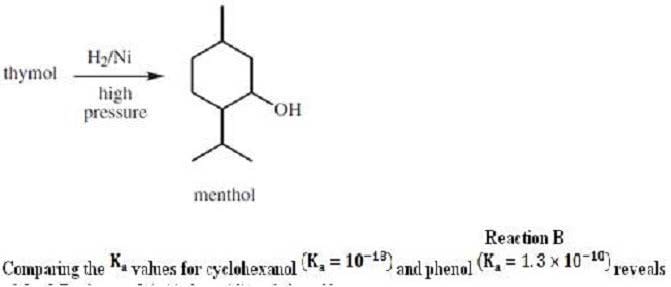
I. The exceptionally strong hydrogen bonding possible with phenol facilitates the loss of a proton, making it more acidic than cyclohexanol.
II. Phenol's conjugate base, phenoxide, is stabilized by resonance to a greater extent than phenol itself.
III.
The negative charge of the oxygen atom on the phenoxide ion is delocalized over the benzene ring.
A.
I only
B.
II only
C.
II and III only
D.
I, II, and III
-
Question 555:
Alleles are created when a single gene undergoes several distinct mutations. These alleles may have different dominance relationships with one another; for example, there are three alleles coding for the human blood groups, the IA, IB, and i alleles. Both the IA and IB alleles are dominant to the i allele, but IA and IB are codominant to each other.
A multiple-allele system has recently been discovered in the determination of hair coloring in a species of wild rat. The rats are found to have one of three colors: brown, red, or white. Let B = the gene for brown hair; b = the gene for red hair; and w = the gene for white hair. The results from nine experimental crosses are shown below. The males and females in Crosses 1, 2, and 3 are all homozygous for hair color.
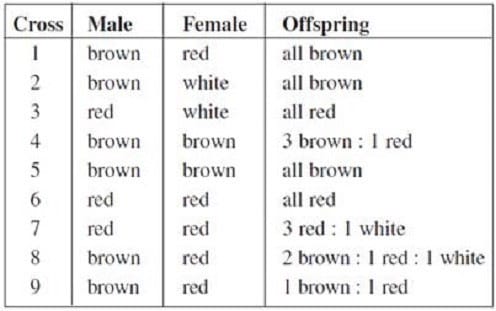
If it were discovered that the alleles for red and white hair were actually incompletely dominant and produced a pink hair color in rats with one copy of each allele, what would be the expected phenotypic ratio in a cross between a Bb male and a pink female?
A. 2 brown : 1 red : 1 white
B. 2 brown : 1 red : 1 pink
C. 1 brown : 2 white : 1 pink
D. 1 brown : 1 white
-
Question 556:
Compounds containing a hydroxyl group attached to a benzene ring are called phenols. Derivatives of phenols, such as naphthols and phenanthrols, have chemical properties similar to those of phenols, as do most of the many naturally-occurring substituted phenols. Like other alcohols, phenols have higher boiling points than hydrocarbons of similar molecular weight. Like carboxylic acids, phenols are more acidic than their alcohol counterparts. Phenols undergo a number of different reactions; both their hydroxyl groups and their benzene rings are highly reactive. A number of chemical tests can be used to distinguish phenols from alcohols and carboxylic acids.

Thymol, a naturally occurring phenol, is an effective disinfectant that is obtained from thyme oil. Thymol can also be synthesized from m-cresol, as shown in Reaction A below. Thymol can then be converted to menthol, another naturally-occurring organic compound; this conversion is shown in Reaction B.
Reaction A

Reaction B

Reaction A is an example of:
A. a free radical substitution.
B. an electrophilic aromatic substitution.
C. an electrophilic addition.
D. a nucleophilic aromatic substitution.
-
Question 557:
Alleles are created when a single gene undergoes several distinct mutations. These alleles may have different dominance relationships with one another; for example, there are three alleles coding for the human blood groups, the IA, IB, and i alleles. Both the IA and IB alleles are dominant to the i allele, but IA and IB are codominant to each other.
A multiple-allele system has recently been discovered in the determination of hair coloring in a species of wild rat. The rats are found to have one of three colors: brown, red, or white. Let B = the gene for brown hair; b = the gene for red hair; and w = the gene for white hair. The results from nine experimental crosses are shown below. The males and females in Crosses 1, 2, and 3 are all homozygous for hair color.
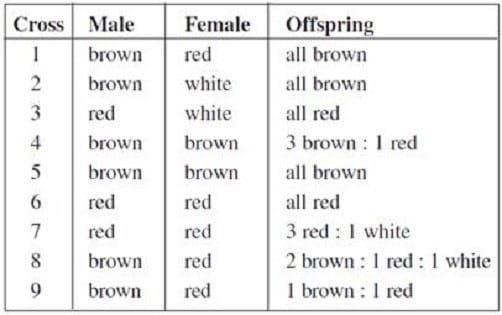
A white male is crossed with the heterozygous red female from Cross 9. What is the expected ratio of red to white offspring?
A. 3:1
B. 1:3
C. 1:1
D. 2:1
-
Question 558:
Alleles are created when a single gene undergoes several distinct mutations. These alleles may have different dominance relationships with one another; for example, there are three alleles coding for the human blood groups, the IA, IB, and i alleles. Both the IA and IB alleles are dominant to the i allele, but IA and IB are codominant to each other.
A multiple-allele system has recently been discovered in the determination of hair coloring in a species of wild rat. The rats are found to have one of three colors: brown, red, or white. Let B = the gene for brown hair; b = the gene for red hair; and w = the gene for white hair. The results from nine experimental crosses are shown below. The males and females in Crosses 1, 2, and 3 are all homozygous for hair color.

Based on the experimental results, what is the genotype of the female in Cross 5?
A. Bb
B. BB or Bb
C. BB or Bw
D. BB, Bb, or Bw
-
Question 559:
Alleles are created when a single gene undergoes several distinct mutations. These alleles may have different dominance relationships with one another; for example, there are three alleles coding for the human blood groups, the IA, IB, and i alleles. Both the IA and IB alleles are dominant to the i allele, but IA and IB are codominant to each other.
A multiple-allele system has recently been discovered in the determination of hair coloring in a species of wild rat. The rats are found to have one of three colors: brown, red, or white. Let B = the gene for brown hair; b = the gene for red hair; and w = the gene for white hair. The results from nine experimental crosses are shown below. The males and females in Crosses 1, 2, and 3 are all homozygous for hair color.
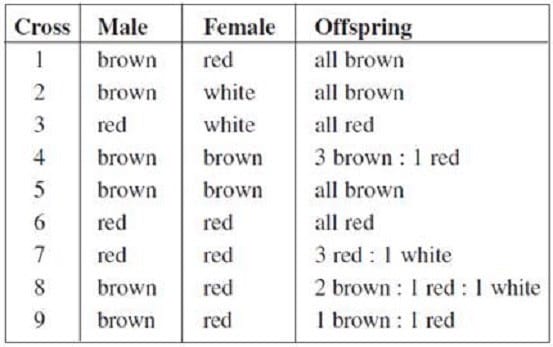
If a large number of brown offspring from Cross 8 are mated with each other, what is the expected percentage of white offspring?
A. 6.25%
B. 8.33%
C. 12.5%
D. 25%
-
Question 560:
A student was given a sample of an unknown liquid and asked to determine as much as possible about its structure. He was told that the compound contained only carbon, hydrogen, and oxygen, and had only one type of functional group. The student found its boiling point to be 206. Using mass spectroscopy, he determined its molecular weight to be 138 g/mol. Finally, he took the infrared spectrum of the compound, which is shown below.
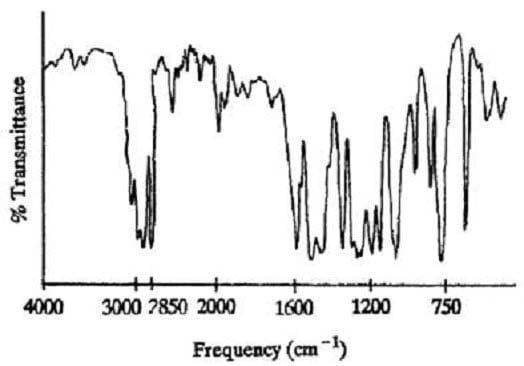
From this spectrum, the student quickly reached a conclusion about the functional group. He then turned his attention to the fingerprint region of the compound, which generally has a complicated pattern of peaks that are determined by the structure of the hydrocarbon portion of a molecule. The student decided that the large peak at 750 cm-1 must indicate that this was a disubstituted aromatic compound.
The student decides to carry out some simple tests on the compound in order to confirm his identification. Which of the following statements is NOT true?
A. He could distinguish between a phenol and a benzoic acid by seeing if the unknown can be extracted with a weak base.
B. He could distinguish between a benzyl aldehyde and a benzyl ketone by seeing if the unknown will react with cold KMn.
C. He could distinguish between a benzyl alcohol and a phenol by attempting to dissolve the unknown in an aqueous solution of HCl.
D. He could distinguish between a benzyl alcohol and a benzoic ester by attempting to dissolve the unknown in an aqueous solution of NaOH.
Related Exams:
Tips on How to Prepare for the Exams
Nowadays, the certification exams become more and more important and required by more and more enterprises when applying for a job. But how to prepare for the exam effectively? How to prepare for the exam in a short time with less efforts? How to get a ideal result and how to find the most reliable resources? Here on Vcedump.com, you will find all the answers. Vcedump.com provide not only Medical Tests exam questions, answers and explanations but also complete assistance on your exam preparation and certification application. If you are confused on your MCAT-TEST exam preparations and Medical Tests certification application, do not hesitate to visit our Vcedump.com to find your solutions here.